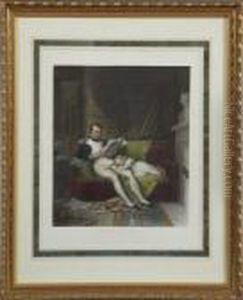Charles Steueben Paintings
Charles Steuben, born Charles Auguste Guillaume Steuben, was a notable French painter of the late 18th and early 19th centuries, whose career spanned a dynamic period in European art, reflecting the shifts from Neoclassicism towards Romanticism. Born on April 18, 1788, in Landau, in the German Palatinate, he later moved to France, where he became a central figure in the French artistic scene. Despite his German origins, Steuben is often associated with French art due to his significant contributions and the majority of his career spent in France.
Steuben showed an early interest in art and quickly developed his skills, leading him to study under François Gérard, a prominent French painter known for his portraits and historical scenes. Under Gérard's mentorship, Steuben honed his technique, particularly in the use of color and composition, which would become hallmarks of his style. His works often depicted historical events and figures, military scenes, and classical mythology, imbued with a sense of drama and emotion characteristic of the Romantic movement. One of his most famous works is 'The Bivouac of Napoleon on the Battlefield of Wagram,' which exemplifies his skill in capturing the grandeur and intensity of historical moments.
Throughout his career, Steuben enjoyed the patronage of important figures of his time, including the French royal family. His paintings were celebrated for their detailed realism, vibrant expression, and the ability to convey the spirit of the subjects he depicted. Despite the political upheavals of his time, including the fall of Napoleon and the restoration of the Bourbon monarchy, Steuben managed to navigate the changing tides of French politics and art, maintaining a successful career.
Charles Steuben's legacy is marked by his contribution to the Romantic movement in France, through his masterful depiction of historical and mythological scenes. He passed away on November 21, 1856, in Paris, leaving behind a body of work that continues to be admired for its emotional depth and technical prowess. His paintings can be found in museums across France and beyond, testament to his enduring influence on the world of art.
